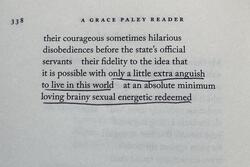Postcards from Yiddishland: Singing Ghetto Songs
I spent the last week of December encamped in a Catskills hotel with about 425 klezmorim, dancers, artists, students, and lovers of Yiddish from around the world. We had gathered for the 23rd annual KlezKamp, a music and culture extravaganza organized by Living Traditions, a nonprofit dedicated to Yiddish cultural continuity and community. During the day, we took classes on everything from Hasidic dance to world Jewish foodways; at night, we danced to the newest and oldest in Ashkenazi music in the hotel ballroom with its famous gold lamè curtains. The intense formation of a weeklong community, the exuberant creativity and revelry, the shvitz—it was a little like Burning Man, actually, but with Catskills food.
This year's KlezKamp theme was 'Mameloshn: Women in Yiddish Culture,' and there was no shortage of material on that subject. Two matriarchs of Yiddish culture (and winners of the NEA National Heritage Fellowship) taught classes: the drummer Elaine Hoffman Watts, a third-generation klezmer musician from Philly and the first woman admitted to Curtis Institute, who is currently recording the music of her father and grandfather; and Beyle Schaecter-Gottesman, the poet and songwriter, who is the subject of a new documentary.
One of the highlights of this year's KlezKamp for me was a workshop exploring twentieth century songs on the theme 'Women and War,' led by vocalist Adrienne Cooper and accompanied on piano by Marilyn Lerner. The lyrics documented Yiddish women's lives in wartime—mothers, girlfriends, and widows, singing in grief and anger—and Cooper's commentary guided us as we sang and reflected on this complex material. One song, "Rivkele di Shabesdike," described the longing of the Bialystok ghetto women whose husbands were murdered by Germans on shabbos in July 1942. This song, taught by the Bund to communicate news within the Jewish community, was memorized so deeply that survivors could often sing it verbatim decades later.
A more abstract song, the poet Itzik Manger's "Unter di khurves fun poyln/Under the ruins of Poland," begins:
Unter di khurves fun poyln Under the ruins of Poland,
A kop mit blonde hor A head with blonde hair
Der kop un say der khurbn The head and the destruction
Beyde zaynen vor. Both are truths.
It closes with an almost folkloric image of a "groyser shive-foygl," a great bird of mourning, carrying a song of grief on its wings. Beyle Schaecter-Gottesman, who was taking the class, commented that she remembered Manger singing it differently. When first written, the melody was darker; it was later brightened, perhaps from the post-war tendency to remake Shoah/khurbn-era written material into its own memorial.
A few songs adapted popular lullabies, with their tender images of cradles and comfort, as though explaining to children the violence around them. An example of the altered lullaby was "Dremlen feygl af di tsaygn/Drowsing birds," written by partisan Leah Rudnicki in the Vilne ghetto. Its theme was echoed in "Babi Yar," a song containing this intimate image of maternal self-sacrifice: "Volt ikh opgeshorn/Di tsep mayne, di lange,/Un af zey dos vigl,/Dos vigl oyfgehangn./...Helft mir, mames, helft mir/Dem Babi Yar farvign" (I would have cut off my long braid to hang your cradle from... Help me, mothers, help me, cradle Babi Yar). Because of the emotional response of the class to this piece, Cooper asked our permission to proceed before singing it. She had also recently taught this material with Schaecter-Gottesman to a class of mostly young gentiles in Germany, which required the same compassionate sensitivity towards students as they encountered their national past through these songs.
The most compelling song portrayed a microcosm of the ghetto. "Koyft Geto Beygelekh" is a disarmingly rollicking song about how people adapted to life under siege: a son tears off his patch (i.e., yellow star), puts on an overcoat, sneaks past the gate to sell fake gems and "become a little magnate"; a daughter works for the committee selling "burnt ghetto bagels"; and amidst the misery, bakers get rich by collaborating with the authorities, "making bags of butter and schmaltz." The author, who had adapted it from an earlier, non-satiric pop song, does not shy away from naming those who profit from others' suffering.
Yet the final stanza dares the listener to "sing ghetto songs, play ghetto fiddles/rejoice, Jews, in rest and calm/go to a concert and play a game of cards/drink schnapps by the quart and enjoy dessert, too." This seeming paradox speaks to the recurring question of how, exactly, one should sing ghetto songs in the present day. Adrienne Cooper's parting advice: "Accept these songs openheartedly, with a willingness to go where the songs take us and to find energy and joy in them."
Cooper's thought-provoking class was for me a model of how to inclusively teach Yiddish arts in their historical context, and I'm curious to hear your stories of being taught (or teaching) Holocaust-era material. Were women's experiences in wartime ever specifically discussed in the classroom? Did you feel that Yiddish culture was obscured in the process of studying Holocaust history?






If anyone knows of any recordings of these particular songs, I'd love to hear them, it sounds interesting.
Do you know of any recordings of these songs? We're doing a project centred around Amsterdam, but this would be an excellent sidenote if available.
this may be a bit off topic but your interesting post on Jewish Women and words makes me think today of a Jewish woman very recently deceased. She was my grandmother and she often wrote poems for family occasions. The poems were not earth shattering but, in the context of a family ritual like a group dinner, they focused our emotional attention.
At the time, this seemed like a quaint idiosyncracy but after reading more Yiddish poetry, it was obviously part of a normative cultural tradition. The most telling attribute of this tradition is that the poems were not expected to be transcendent- more like Poor Richard's Alamanac ("a penny saved is a penny earned") than Shelley.